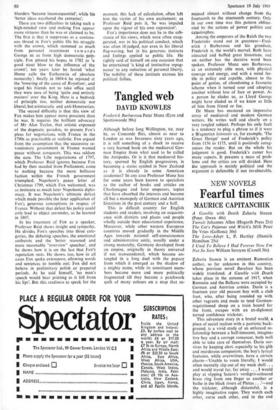NEW NOVELS
Fearful times
MAURICE CAPITANCHIK
A Gamble with Death Zaharia Stancu (Peter Owen 40s) Tumult Johannes Allen (Hogarth Press 21s) The Cat's Pajamas and Witch's Milk Peter De Vries (Gollancz 30s) The Love-Adept L P. Hartley (Hamish Hamilton 25s) I Used To Believe I Had Forever Now Fm Not So Sure William Saroyan (Cassell 36s) Zaharia Stancu is an eminent Rumanian author, so far unknown in this country, whose previous novel Barefoot has been widely translated. A Gamble with Death takes place in the autumn of 1917, when Rumania and the Balkans were occupied by German and Austrian armies. Dane is a fourteen year old peasant boy with a club foot, who, after being rounded up with other vagrants and made to tend German- requisitioned sheep on a train bound for the front, escapes with an ex-diplomat turned confidence trickster.
This adventure story in a brutal world, a piece of social realism with a patriotic back- ground, is a vivid study of an enforced re- lationship between a half-innocent, imagina- tive boy and a corrupt romancer, both well able to take care of themselves. Dark sur- vives by keeping alert, especially to his glib and murderous companion; the boy's lyrical fantasies, while overwritten, have a certain charm—'Unable to roam literally, I would often mentally slip out of my weak shell ... and would travel far, far away .. . I would play at slipping Saturn's verdigris-coloured brass ring from one finger to another or bathe in the black rivers of Plutus .'—and the trickster, although distasteful, is a highly imaginative rogue. They watch each other, curse each other, and in the end achieve a degree of affection. The tone of this work gives the impression that brutality and ruthlessness are almost all there is to life; while this is unconvincing, the book as a whole, though occasionally predictable, does carry conviction as a portrayal of a singularly hard situation at a particularly oppressive time. The poverty-stricken world of A Gamble with Death is matched at the opposite ex- treme by the affluent one of Tumult. Mr Allen's book is in the form of a first-person confession, by a Danish businessman in his fifties, about his infatuation for a sixteen year old delinquent. Bored by his family and social life, he is an easy prey for the enig- matic and sexually uninhibited Sonia.
This simply-written little novel about a common plight has value because the cen- tral character is clear-sighted about every- thing except his own psychology. His com- ments, on his business trips, when he stays in 'Europe's God-forsaken hotel rooms', and on his family's puerile domesticity (*Dinner progressed as it usually does in the so-called better homes on a Sunday evening. Intense conversation about the food and wine, a little boring chatter about the events of the week . . .'), are entirely apt, but he does not understand that what binds him to a worthless mistress is his desire for an ob- ject-relationship with an object he can never completely possess. This is a persuasive, if slight, study of the ways in which fear can both inhibit love and enhance desire.
The heroes of Peter De Vries's two Ameri- can comedies are also dominated by fear, that of being ridiculous or inadequate in the eyes of other people. In The Cat's Paja- mas, Hank Tattersall, an absurdly immature fantasist, initially a college lecturer, sabo- tages himself, moving progressively down- hill out of the worlds of advertising and television, and finally his marriage, into a philosophy of total squalor. Witch's Milk is the story of the marriage of Tilly Shilepsky to the slightly crippled and rather less intel- ligent Pete Seltzer; Tilly's realisation, that it is precisely her husband's hopelessness she loves, finally saves their relationship. These are both studies of different kinds of failure in a success-ridden world, but the over- blown verbal fantasy cloys in both stories, and falls into sentimentality in the second.
L. P. Hartley's The Go-Between was an absorbing story of a boy observing the passion of two adults. In The Love-Adept, a novelist, having written a book about a platonic sugar-daddy who blindly watches over the affair of an actress and her chauffeur, corresponds about the merits and demerits of his work with four female friends, all called Elizabeth. The discussions are of small interest to anyone save the author himself, although this would not matter except that the extracts we are given show so very little sign of life. Mr Hartley's concern for the novel as a form is admir- able, but it seems a pity that he saw fit to publish this one.
Less cautious than Mr Hartley, William Saroyan is one of the most well-meaning practitioners of the American literary creed of being one's verbose self and to hell with the consequences. I Used to Believe etc is a motley collection of Saroyanalia, garnered from the years, about Mr Saroyan, his views and news. The best piece is a pre- viously unpublished book-review, called 'The Unknown Soldier Identified', one of the few in which a subject other than the author's self, or life, is allowed to emerge. Sadly, despite the mark of a powerful per-
sonality, there is a preponderance of sheer waffle. Of his meeting with the ill-fated Armenian writer Charentz, in Moscow, he says: 'I remarked that while I did not know his writing it seemed to me that although he wrote in Armenian he was essentially a world writer.' Was ever language more lovingly ill-used?



































 Previous page
Previous page